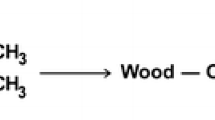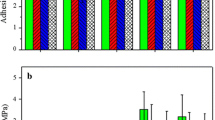Abstract
Swelling and shrinkage of wood has a major effect on the performance of coatings applied to its surface. Altering the molecular structure of wood by a reaction with acetic anhydride is known to improve the dimensional stability of wood considerably. Such acetylation of wood was shown to have no effect on the drying characteristics and adhesion of applied coatings. Weathering performance of coatings was improved considerably. A color stabilizing effect was achieved with acetylated Scots pine with and without a clearcoating.
Similar content being viewed by others
References
Rowell, R.M., “Chemical Modification of Wood,”Forest Products Abstracts, 6 (12): 363–382 (1983).
Kumar, S., “Chemical Modification of Wood,”Wood Fiber Sci., 26 (2): 270–280 (1994).
Clemons, C., Young, R.A., and Rowell, R.M., “Moisture Sorption Properties of Composite Boards from Esterified Aspen Fiber,”Wood Fiber Sci., 24 (3): 353–363 (1992).
Goethals, P. and Stevens, M., “Dimensional Stability and Decay Resistance of Wood upon Modification with Some New Type Chemical Reactants,” International Research Group on Wood Preservation, Document No. IRG/WP/94-40028, 1994.
Matsuda, H., “Preparation and Properties of Oligoesterified Wood Blocks Based on Anhydride and Epoxide,”Wood Sci. Tech., 27: 23–34 (1993).
Rowell, R.M.,Chemical Modification of Wood—Advantages and Disadvantages, American Wood-Preservers’ Association, 1975.
Rowell, R.M., “Nonconventional Wood Preservation Methods,”Wood Technology: Chemical Aspects, Chapter 4, page 47–56, 1977.
Rowell, R.M. and Ellis, W.D., “Effects of Moisture on the Chemical Modification of Wood with Epoxides and Isocyanates,”Wood Fiber Sci., 16 (2): 257–267 (1984).
Rowell, R.M. and Banks W.B., Water Repellency and Dimensional Stability of Wood, USDA Forest Products Laboratory. General Technical Report FPL-50, 1985.
Beckers, E.P.J. and Militz, H., “Acetylation of Solid Wood—Initial Trials on Lab and Semi Industrial Scale,” Second Pacific Rim Bio-Based Composites Symposium, Vancouver, B.C., Canada, 1994.
Goldstein, I.S., Jeroski, E.B., Lund, A.E., Nielson J.F., and Weaver, J.W., “Acetylation of Wood in Lumber Thickness,”Forest Products J., 11(8):363–370 (1961).
Rowell, R.M. and Plackett, D.V., “Dimensional Stability of Flakeboards Made from AcetylatedPinus radiata Heartwood or Sapwood Flakes,”New Zealand J. Forestry Sci., 18(1): 124–131 (1988).
Rowell, R.M., Feist, W.C., and Ellis, W.D., “Weathering of Chemically Modified Southern Pine,”Wood Sci., 13(4): 202–208 (1981).
Feist, W.C., Rowell, R.M., and Ellis, W.D., “Moisture Sorption and Accelerated Weathering of Acetylated and Methacrylated Aspen,”Wood Fiber Sci., 23(1): 128–136 (1991).
Arnold, M., and Sell, J., Künstliche Bewitterung von Holz und Holzanstrichen: Vergleich zweier Gerätetypen.Holz als Roh- und Werkstoff 48: 138–143 (1990).
Acker Van, J., Stevens, M., and Nys, M., “Xenon Simulation of Natural Weathering of External Joinery Preserving—Finishing Systems,” International Research Group on Wood Preservation. Document No. IRG/WP/2412-92, 1992.
Bravery, A.F. and Dickinson, D.J., “Artificial Weathering as an Aid to Assessing the Effectiveness of Chemicals for Preventing Blue Stain in Service—a Co-operative Study,” International Research Group on Wood Preservation, Document No. IRG/WP/2215, 1984.
Sell, J. “Physikalische Vorgäge in Wetterbeanspruchten Holzbauteilen Fensterrahmen,”Holz als Roh- und Werkstoff 43: 259–267, 1985.
Pecina, H., and Parzycki, O., “Untersuchungen über die Benetzbarkeit chemisch modifizierter Hölzer,”Holz als Roh- und Werkstoff 48: 61–65, 1990.
Feist, W.C., Rowell, R.M., and Youngquist, J.A., “Weathering and Finish Performance of Acetylated Aspen Fiberboard,”Wood Fiber Sci., 23(2): 260–272 (1991).
MacLeod, I.T., Scully, A.D., Ghiggino, K.P., Ritchie, P.J.A., Paravagna, O.M., and Leary, B., “Photodegradation at the Wood-Clearcoat Interface,”Wood Sci. Tech., 29: 183–189 (1993).
Feist, W.C. and Hon, D.N.-S., “Chemistry of Weathering and Protection” inThe Chemistry of Solid Wood, R.M. Rowell (Ed.), Advances in Chemistry Series, No. 207, American Chemical Society, Washington, D.C., Chapter 11, pp. 401–451, 1984.
Hon, D.N.-S. “Stabilization of Wood Color: Is Acetylation Blocking Effective,”Wood Fiber Sci., 27(4): 360–367 (1995).
Author information
Authors and Affiliations
Additional information
Wildekamp 1C, P.O. Box 497, NL-6700 AL, Wageningen, The Netherlands.
Laboratorium voor Houttechnologie, Coupure Links 653, B-9000 Gent, Belgium.
Rights and permissions
About this article
Cite this article
Beckers, E.P.J., de Meijer, M., Militz, H. et al. Performance of finishes on wood that is chemically modified by acetylation. Journal of Coatings Technology 70, 59–67 (1998). https://doi.org/10.1007/BF02697812
Issue Date:
DOI: https://doi.org/10.1007/BF02697812




